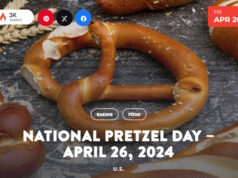
National Candy Cane Day is observed across the United States each year on December 26.
As you’ll see below references to candy cane records can differ greatly…but they are fun to read.
- The earliest verifiable reference to stick candy is a record of the 1837 Exhibition of the Massachusetts Charitable Mechanic Association, where confections were judged competitively.
- The first historical reference in America to the candy cane dates back to 1847. A German immigrant from Wooster, Ohio decorated his Christmas tree with candy canes.
- In 1844, a recipe for a straight peppermint candy stick, which was white with colored stripes, was published. However, some stories tell of all white candy sticks in much earlier times. There are folklore tales of the origin of the candy cane, yet there is no documented proof of its real beginning.
- The first candy cane was made over 350 years ago.
- It has been mentioned in literature since 1866 and was first known to be mentioned in association with Christmas in 1874.
- As early as 1882, candy canes have been hung on Christmas trees.
- While most candy canes are not sugar or calorie-free, they do not have any fat or cholesterol.
- The first machine to make candy canes was invented in 1921 by Brasher O. Westerfield. Until then, they were made by hand.
- Alain Roby, Geneva pastry chef, holds the Guinness World Record for the longest candy cane, measuring 51 feet long.
- It was not until the mid 1900’s that candy canes with red stripes appeared in Sweden.
- The curvy shape of the candy cane is credited to a choirmaster who worked at the Cologne Cathedral in Germany. It is believed that he bent the peppermint sticks to look like the canes that shepherd’s used.
- Other sources credit the bending of the candy maker in Indiana. It is rumored that he also decided to added three red stripes to the candy cane which were meant to represent the Holy Trinity.
- Some people believe that the reason the peppermint sticks were bent into their curvy shape was so that they could look like a “J,” for Jesus.
- Brasher O. Westerfield invented a machine that could automatically make candy canes in 1921, . Before this each cane was made by hand.
- Nearly 2 billion candy canes will be sold in the four weeks before Christmas and Hanukkah.
- The average sized candy cane (5 inch) weighs roughly half an ounce and only has 50 calories.
- Fifty-four percent of kids suck on candy canes, compared to the 24 percent who just go right for the big crunch. As you may have been able to guess, of those surveyed, boys were nearly twice as likely to be crunchers.
- A priest played a major role in the candy’s move to mass production. Bobs (that’s right; no apostrophe) Candies was the first company to really hang its hat on the sweet, striped hook. Lt. Bob McCormack began making candy canes for his kids in the 1920s, and they were such a hit he decided to start mass-producing them. With the help of his brother-in-law, a Catholic priest named Gregory Harding Keller (and his invention, the Keller Machine), McCormack was eventually able to churn out millions of candy canes a day.
- Here’s how they make candy canes at Disneyland—it’s a painstaking (and beautiful) technique.
Sources:












